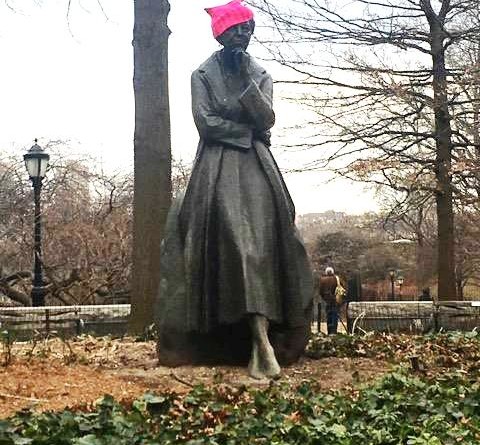Being There, in D.C.
By Alison Osius
The event seemed not a march but a titanic massing, too vast to take shape. The sea of bobbing, floating rose-petal hats stretched way out of sight. At the Women’s March on Washington, drawing hundreds of thousands more than even expected, my crew never heard a speaker, never even made it onto the mall. We followed an incipient flow, amid the waving, vivid signs.
Bumping along, we entered the thickest vein of the crowd, a surge of faces and shoulders and defiant pink hats, all crisscrossed by ladder-like lines of people clutching each other’s arms and shoulders, apologizing that they were only trying to stay together. I could only see Lucy and Mary in front of me, feel Ann on my sleeve from behind.
In time Mary turned: “I’ve lost them,” she said. “Sorry.” Three of us were gone. Ahead somewhere.
“Hey, can you please let us through?” a woman appearing behind me asked. “I’ve got a kid here who needs to get out.”
I echoed her, through cupped hands. “Hey, please move! A kid needs to come out.”
A coltish girl of about 14, ashen, her lip quivering, passed as somehow all the elbows and torsos parted.
I struggled toward a lamppost, to shimmy up a bit and look around. We’d lost cell service.
Our crew was seven: two teacher/educators, a doctor, a lawyer, a librarian, this writer and a zookeeper. We had amassed from Colorado, Utah, Maryland, Massachusetts, Pennsylvania and even — my sister made a five-day roundtrip for the occasion — Abu Dhabi. Our ages spanned 15 years. We carried signs varying from “Not my values” to “No electoral college for Congress” to my two-foot-tall “FREE PRESS” written on a pillowcase donated by my mother. We stayed at her house, in Annapolis, within an hour of D.C.
In the melee, simply trying to cross out, I was pushed. Each time, as I turned, someone said gently, “I’m sorry. I was pushed.”
Lucy said during one instant she “felt the whole crowd lean.”
Yet all day we received only kindness and good nature from the multitudes. Despite the crowds. The scarce toilets (we, personally, practiced voluntary dehydration). The loss of communications. When service returned, we found our friends 10 blocks away.
The night before I did worry. Given security risks, we could carry only small purses, and no knapsacks unless transparent. Instructions raced around to pen our names, phone numbers and medical allergies (twice) on our forearms, to stay at the edges of the crowd, to bring goggles and “tightly woven” scarves in case of tear gas. I received a stream of caring, concerned messages from friends, some I hadn’t heard from in years, saying to be safe. I thought of the event’s density and visibility, and of the Boston Marathon.
Eventually we followed general movement down Constitution Avenue, passing the White House. Beyond it was a 30-foot float backed by tall letters spelling out T-R-U-M-P and manned by, according to a sign, “Veterans & Bikers.” A dozen occupants stood, some mock smiling and waving, several continually taking marchers’ pictures, one making strange dance-like geometric hand movements. “Baiting the crowd,” as Rebecca put it. Shouts flew, motorcycles revved and roared and sirens screamed.
“If there’s trouble,” Elizabeth said in my ear, nodding behind us, “run down into that building.”
Amid the cacophony and energy, I felt certain something was about to happen, to blow. Yet the float, ushered by police, moved slowly away.
That night pink hats thronged the sidewalks, the restaurants. At the airport the next day I saw more, and, wearing mine (knitted by a friend), received greetings, thanks and high fives from passing strangers. I met women from France and the Netherlands who had flown in for the march. Another woman said her Friday-night flight from Boston was 100 percent filled with marchers.
“I wish I was there,” my mother, who has a bad back, had posted on the day. She watched the news for hours.
On the streets, with my sister and friends of decades, I saw a protest evolve into a celebration of protest, when half a million people there and millions worldwide gathered in peace and unity. “It gave me faith,” a friend later said.
The wave of activism continues, and pink hats keep popping up: on the head of a statue in New York, drawn on a black Rosie the Riveter on a New Yorker cover, or darting around in my mountain town. The other day I walked by a female-shaped sculpture on Main Street and imagined plunking my hat on her, a bright symbol, but I still need it.
Alison Osius lives in Carbondale, where she is a climber, skier and magazine editor. Her column “Femaelstrom” appears on the third Friday of each month in the Glenwood Post Independent. Contact her at aosius@hotmail.com.

